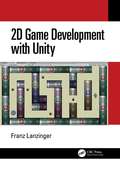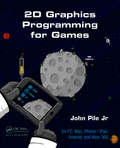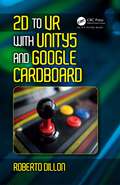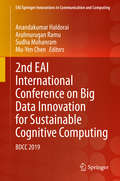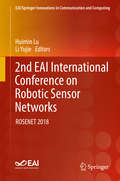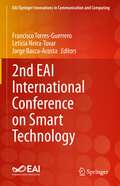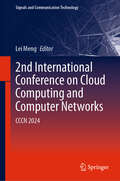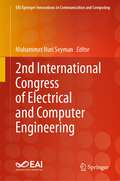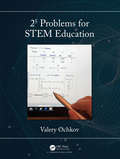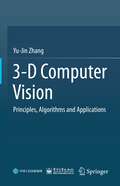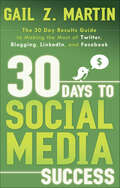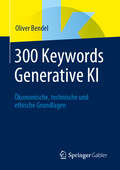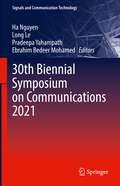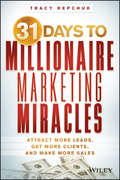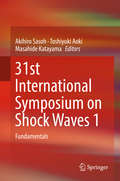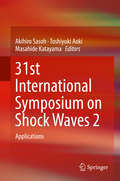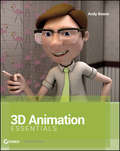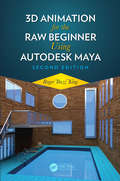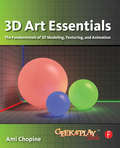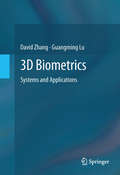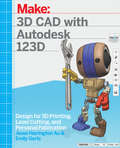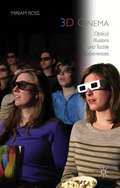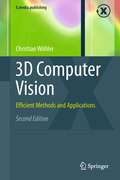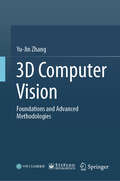- Table View
- List View
2D Game Development with Unity
by Franz LanzingerThis book teaches beginners and aspiring game developers how to develop 2D games with Unity. Thousands of commercial games have been built with Unity. The reader will learn the complete process of 2D game development, step by step. The theory behind each step is fully explained. This book contains numerous color illustrations and access to all source code and companion videos. Key Features: Fully detailed game projects from scratch. Beginners can do the steps and create games right away. No coding experience is necessary. Numerous examples take a raw beginner toward professional coding proficiency in C# and Unity. Includes a thorough introduction to Unity 2020, including 2D game development, prefabs, cameras, animation, character controllers, lighting, and sound. Includes a step-by-step introduction to Unity 2019.3. Extensive coverage of GIMP, Audacity, and MuseScore for the creation of 2D graphics, sound effects, and music. All required software is free to use for any purpose including commercial applications and games. Franz Lanzinger is the owner and chief game developer of Lanzinger Studio, an independent game development and music studio in Sunnyvale, California. He started his career in game programming in 1982 at Atari Games, Inc., where he designed and programmed the classic arcade game Crystal Castles. In 1989, he joined Tengen, where he was a programmer and designer for Ms. Pac-Man and Toobin' on the NES. He co-founded Bitmasters, where he designed and coded games including Rampart and Championship Pool for the NES and SNES, and NCAA Final Four Basketball for the SNES and Sega Genesis. In 1996, he founded Actual Entertainment, publisher and developer of the Gubble video game series. He has a B.Sc. in mathematics from the University of Notre Dame and attended graduate school in mathematics at the University of California at Berkeley. He is a former world record holder on Centipede and Burgertime. He is a professional author, game developer, accompanist, and piano teacher. He is currently working on remaking the original Gubble game in Unity and Blender.
2D Graphics Programming for Games
by John Pile Jr.The success of Angry Birds, Peggle, and Fruit Ninja has proven that fun and immersive game experiences can be created in two dimensions. Furthermore, 2D graphics enable developers to quickly prototype ideas and mechanics using fewer resources than 3D.2D Graphics Programming for Games provides an in-depth single source on creating 2D graphics that c
2D to VR with Unity5 and Google Cardboard
by Roberto DillonThe book provides an up-to-date introduction to the latest version of Unity and its workflow by guiding readers through various prototypes. These range from 2D to 3D game concepts for PC and mobile, will allow readers to get acquainted with several important concepts and allow them to become competent Unity developers able to learn at their own pace. The book starts by introducing Unity and proceeds in building a basic understanding of its main components by developing a first, simple 2D game before proceeding in developing a full casual game to development of a simple but immersive 3D game concept to be tested first on PC before exploring how to port it for mobile VR.using Google Cardboard.
2nd EAI International Conference on Big Data Innovation for Sustainable Cognitive Computing: BDCC 2019 (EAI/Springer Innovations in Communication and Computing)
by Anandakumar Haldorai Arulmurugan Ramu Sudha Mohanram Mu-Yen ChenThis proceeding features papers discussing big data innovation for sustainable cognitive computing. The papers feature details on cognitive computing and its self-learning systems that use data mining, pattern recognition and natural language processing (NLP) to mirror the way the human brain works. This international conference focuses on cognitive computing technologies, from knowledge representation techniques and natural language processing algorithms to dynamic learning approaches. Topics covered include Data Science for Cognitive Analysis, Real-Time Ubiquitous Data Science, Platform for Privacy Preserving Data Science, and Internet-Based Cognitive Platform. The 2nd EAI International Conference on Big Data Innovation for Sustainable Cognitive Computing (BDCC 2019) took place in Coimbatore, India on December 12-13, 2019.Contains proceedings from 2nd EAI International Conference on Big Data Innovation for Sustainable Cognitive Computing (BDCC 2019), Coimbatore, India, December 12-13, 2019;Features topics ranging from Data Science for Cognitive Analysis to Internet-Based Cognitive Platforms;Includes contributions from researchers, academics, and professionals from around the world.
2nd EAI International Conference on Robotic Sensor Networks: ROSENET 2018 (EAI/Springer Innovations in Communication and Computing)
by Huimin Lu Li YujieThis book provides scientific research into Cognitive Internet of Things for Smart Society, with papers presented at the 2nd EAI International Conference on Robotic Sensor Networks. The conference explores the integration of networks and robotic technologies, which has become a topic of increasing interest for both researchers and developers from academic fields and industries worldwide. The authors posit that big networks will be the main approach to the next generation of robotic research, with the explosive number of networks models and increasing computational power of computers significantly extending the number of potential applications for robotic technologies while also bringing new challenges to the network's community. The 2nd EAI International Conference on Robotic Sensor Networks was held 25-26 August 2018 at the Kitakyushu International Conference Center (MICE), Kitakyushu, Japan.
2nd EAI International Conference on Smart Technology (EAI/Springer Innovations in Communication and Computing)
by Leticia Neira-Tovar Francisco Torres-Guerrero Jorge Bacca-AcostaThis book presents the proceedings of 2nd EAI International Conference on Smart Technology (MTYMEX), which took place April 27th, 2021, online and in Monterrey, Mexico. MTYMEX is an international conference aimed at demonstrating the potential of new applications for the Internet in the future. The authors offer perspectives on research on smart technologies in society, including the results of research projects on virtual reality, blockchain, artificial intelligence, and smart cities. The book offers examples of applications with smart technologies in different knowledge areas. The conference brings together the academic, research and private sectors working on applications and smart devices for e-health and smart cities.
2nd International Conference on Cloud Computing and Computer Networks: CCCN 2024 (Signals and Communication Technology)
by Lei MengThe book consists of peer reviewed and presented papers of the 2nd International Conference on Cloud Computing and Computer Network (CCCN 2024), which took place in Singapore during April 19-21, 2024. The conference is held annually to gather scholars, researchers and engineers working in the field of cloud computing to share their newest research findings and results, discuss and exchange their thoughts and information, and learn about cutting-edge technologies. The papers are solicited on a broad range of topics, including cloud computing and semantic web technologies, cloud computing models, simulations and designs, cloud computing applications, cloud computing services, mobile cloud networking, service-oriented architecture in cloud computing. Case studies and theories in cloud computing are also explored, as well as cloud storage and file systems, Blockchain for emerging networks, network management, measurement and analysis, and network virtualization. Presents papers from the International Conference on Cloud Computing and Computer Network (CCCN 2024) Includes topics such as semantic web technologies, cloud applications, and cloud computing architecture Relevant to academics, researchers, students, and professionals in cloud computing and computer networks
2nd International Congress of Electrical and Computer Engineering (EAI/Springer Innovations in Communication and Computing)
by Muhammet Nuri SeymanThis proceedings presents the papers included in the 2nd International Congress of Electrical and Computer Engineering (ICECENG), which took place in Bandirma, Turkey, 22-25 November 2023. The conference aims to bring together researchers, developers, and students in computing, technology trends, artificial intelligence, and security who are interested in studying the application of formal methods to the construction and analysis of models describing technological processes at both micro and macro levels. ICECENG’23 also aims to provide a platform for discussing the issues, challenges, opportunities, and findings of computer engineering research. The conference seeks to provide some answers and explore the processes, actions, challenges, and outcomes of learning and teaching.
2⁵ Problems for STEM Education
by Valery Ochkov25 Problems for STEM Education introduces a new and emerging course for undergraduate STEM programs called Physical-Mathematical Informatics. This course corresponds with the new direction in education called STE(A)M (Science, Technology, Engineering, [Art] and Mathematics). The book focuses on undergraduate university students (and high school students), as well as the teachers of mathematics, physics, chemistry and other disciplines such as the humanities. This book is suitable for readers who have a basic understanding of mathematics and math software. Features Contains 32 interesting problems (studies) and new and unique methods of solving these physical and mathematical problems using a computer as well as new methods of teaching mathematics and physics Suitable for students in advanced high school courses and undergraduates, as well as for students studying Mathematical Education at the Master’s or PhD level One of the only books that attempts to bring together ST(E)AM techniques, computational mathematics and informatics in a single, unified format
3-D Computer Graphics
by Samuel R. BussThis introduction to 3D computer graphics emphasizes fundamentals and the mathematics underlying computer graphics, while also covering programming techniques using OpenGL, a platform-independent graphics programming environment. The minimal prerequisites make it suitable for self-study or for use as an advanced undergraduate or introductory graduate text as the author leads step-by-step from the basics of transformations to advanced topics such as animations and kinematics. Accompanying software, including source code for a ray tracing software package, is available freely from the book's web site.
3-D Computer Vision: Principles, Algorithms and Applications
by Yu-Jin ZhangThis textbook offers advanced content on computer vision (basic content can be found in its prerequisite textbook, “2D Computer Vision: Principles, Algorithms and Applications”), including the basic principles, typical methods and practical techniques. It is intended for graduate courses on related topics, e.g. Computer Vision, 3-D Computer Vision, Graphics, Artificial Intelligence, etc. The book is mainly based on my lecture notes for several undergraduate and graduate classes I have offered over the past several years, while a number of topics stem from my research publications co-authored with my students. This book takes into account the needs of learners with various professional backgrounds, as well as those of self-learners. Furthermore, it can be used as a reference guide for practitioners and professionals in related fields. To aid in comprehension, the book includes a wealth of self-test questions (with hints and answers). On the one hand, these questions help teachers to carry out online teaching and interact with students during lectures; on the other, self-learners can use them to assess whether they have grasped the key content.
30 Days to Social Media Success: The 30 Day Results Guide to Making the Most of Twitter, Blogging, LinkedIN, and Facebook (30 Days Series)
by Gail MartinOne of Lifehack.org's Top 20 Books to Read in 2016.Small business owners and solo professionals know they're supposed to use social media to increase sales, but how should they start?Using a unique Rule of 30 approach, 30 Days to Social Media Success is the perfect resource for busy people who want quick results. Thirty short chapters (one for each day of the month) are packed with real-world tips and proven techniques you can use right away.This book makes it easy to tap into the power of today's hottest social media sites to:Get global impact out of press releases, articles, blog posts, and book reviews. Increase your personal and corporate visibility as the go-to expert in your industry. Build relationships with clients and connect with ideal prospects.Network around the world and around the clock with people who need what you have to offer.Wondering how to use social media? Looking for a way to attract new clients without spending a fortune? 30 Days to Social Media Success is for you.
300 Keywords Generative KI: Ökonomische, technische und ethische Grundlagen
by Oliver BendelVon A wie Alignment bis Z wie Zensur: Dieses Nachschlagewerk bietet in mehr als 300 Einträgen einen Überblick über das Thema der generativen KI. Es klärt zahlreiche Fachbegriffe, stellt Anwendungsbereiche vor und diskutiert aktuelle Fragestellungen. Dabei spielen neben technischen und wirtschaftlichen Fragen insbesondere ethische und ästhetische eine Rolle. So wird nach der Schönheit von Artefakten gefragt, es wird die Stellung von Bildern zwischen Kunst und Kitsch ausgeleuchtet, und es wird eine Bias-Diskussion zu Text- und Bildgeneratoren geführt. Insgesamt steht der Nutzen der generativen KI im Vordergrund, und die Freude und Lust, sie zu benutzen. Das Buch richtet sich an ein breites Publikum, etwa Journalisten, Politiker und Bürger, aber auch an Wissenschaftler aller Bereiche.
30th Biennial Symposium on Communications 2021 (Signals and Communication Technology)
by Ha Nguyen Long Le Pradeepa Yahampath Ebrahim Bedeer MohamedThe book presents the proceedings of the 30th Biennial Symposium on Communications 2021 (BSC21), a prestigious international research conference in communications, information theory, and signal processing. Started in 1962 by Queen’s University, Canada, the Symposium is now presented by the Canadian Society of Information Theory. Its 30th edition was hosted virtually by The University of Saskatchewan and held in Saskatoon from June 28 to 30, 2021. Topics include Communication and Information Theory, Coding and Signal Processing for Communications, and Multiple Antenna Systems and Cooperative Communications.
31 Days to Millionaire Marketing Miracles
by Tracy Repchuk31 Days to Millionaire Marketing Miracles is a breakthrough blueprint outlining the proven steps for successfully attracting more leads, getting more clients, and making more sales. Author Tracy Repchuk shows entrepreneurs, business owners, and opportunity-seekers what to do, when to do it, and the order in which it needs to be done to build an online marketing presence that is stable, predictable, and expandable. Whether you want to dominate your market globally or locally, this thirty-one-day guide allows you to take your product, service, or message, and turn it into a moneymaking machine.Best Selling Author Tracy Repchuk is recognized as the Top Woman Speaker in the World for Internet Marketing and an entrepreneur in the IT and internet industry since 1985Serves as a reference guide to newbies and entrepreneurs wanting to turn their passion into profits and accelerate business results31 Days to Millionaire Marketing Miracles guides you along a proven path to profits and shows you an Internet marketing formula that will attract more leads, get more clients, and make more sales
31st International Symposium on Shock Waves 1: Fundamentals
by Akihiro Sasoh Toshiyuki Aoki Masahide KatayamaThis is the first volume of a two volume set which presents the results of the 31st International Symposium on Shock Waves (ISSW31), held in Nagoya, Japan in 2017. It was organized with support from the International Shock Wave Institute (ISWI), Shock Wave Research Society of Japan, School of Engineering of Nagoya University, and other societies, organizations, governments and industry. The ISSW31 focused on the following areas: Blast waves, chemical reacting flows, chemical kinetics, detonation and combustion, ignition, facilities, diagnostics, flow visualization, spectroscopy, numerical methods, shock waves in rarefied flows, shock waves in dense gases, shock waves in liquids, shock waves in solids, impact and compaction, supersonic jet, multiphase flow, plasmas, magnetohyrdrodynamics, propulsion, shock waves in internal flows, pseudo-shock wave and shock train, nozzle flow, re-entry gasdynamics, shock waves in space, Richtmyer-Meshkov instability, shock/boundary layer interaction, shock/vortex interaction, shock wave reflection/interaction, shock wave interaction with dusty media, shock wave interaction with granular media, shock wave interaction with porous media, shock wave interaction with obstacles, supersonic and hypersonic flows, sonic boom, shock wave focusing, safety against shock loading, shock waves for material processing, shock-like phenomena, and shock wave education. These proceedings contain the papers presented at the symposium and serve as a reference for the participants of the ISSW 31 and individuals interested in these fields.
31st International Symposium on Shock Waves 2: Applications
by Akihiro Sasoh Toshiyuki Aoki Masahide KatayamaThis is the second volume of a two volume set which presents the results of the 31st International Symposium on Shock Waves (ISSW31), held in Nagoya, Japan in 2017. It was organized with support from the International Shock Wave Institute (ISWI), Shock Wave Research Society of Japan, School of Engineering of Nagoya University, and other societies, organizations, governments and industry. The ISSW31 focused on the following areas: Blast waves, chemical reacting flows, chemical kinetics, detonation and combustion, ignition, facilities, diagnostics, flow visualization, spectroscopy, numerical methods, shock waves in rarefied flows, shock waves in dense gases, shock waves in liquids, shock waves in solids, impact and compaction, supersonic jet, multiphase flow, plasmas, magnetohyrdrodynamics, propulsion, shock waves in internal flows, pseudo-shock wave and shock train, nozzle flow, re-entry gasdynamics, shock waves in space, Richtmyer-Meshkov instability, shock/boundary layer interaction, shock/vortex interaction, shock wave reflection/interaction, shock wave interaction with dusty media, shock wave interaction with granular media, shock wave interaction with porous media, shock wave interaction with obstacles, supersonic and hypersonic flows, sonic boom, shock wave focusing, safety against shock loading, shock waves for material processing, shock-like phenomena, and shock wave education. These proceedings contain the papers presented at the symposium and serve as a reference for the participants of the ISSW 31 and individuals interested in these fields.
3D Animation Essentials
by Andy BeaneThe essential fundamentals of 3D animation for aspiring 3D artists3D is everywhere--video games, movie and television special effects, mobile devices, etc. Many aspiring artists and animators have grown up with 3D and computers, and naturally gravitate to this field as their area of interest. Bringing a blend of studio and classroom experience to offer you thorough coverage of the 3D animation industry, this must-have book shows you what it takes to create compelling and realistic 3D imagery. Serves as the first step to understanding the language of 3D and computer graphics (CG)Covers 3D animation basics: pre-production, modeling, animation, rendering, and post-productionDissects core 3D concepts including design, film, video, and gamesExamines what artistic and technical skills are needed to succeed in the industryOffers helpful real-world scenarios and informative interviews with key educators and studio and industry professionalsWhether you're considering a career in as a 3D artist or simply wish to expand your understanding of general CG principles, this book will give you a great overview and knowledge of core 3D Animation concepts and the industry.
3D Animation for the Raw Beginner Using Autodesk Maya 2e
by Roger King3D Animation for the Raw Beginner Using Autodesk Maya is a hands-on academic textbook as well as a do-it-yourself training manual for the individual animator. This second edition has been completely rewritten to take into account updates to Autodesk Maya, including Autodesk’s renderer, Arnold. It contains entirely new examples and tutorial lessons. All 612 images are in full color. The book directs the reader to the parts of Maya that must be mastered in order to create complete 3D projects, and thus it simplifies the process of taking on Maya’s vast and intricate interface, while giving the reader a firm foundation on which to build future knowledge of Maya. It also presents brief examples of other popular 3D applications and rendering engines. This principles-based, yet pragmatic book: Introduces the basic steps of the 3D modeling, materials, animation, lighting, and rendering processes. Presents clear and concise tutorials that link key concepts to practical techniques. Includes access to a webpage for the book: https://buzzking.com/AnimationTextbook/AnimationTextbook.html. On this webpage are videos that cover many of the lessons in the book, as well as video tutorials that present bonus material not included in the book. Frees instructors from the painstaking task of developing step-by-step examples to present Maya’s complex interface and basic capabilities. Boasts an easy-to-follow, tutorial-based learning style ideal for individual study by aspiring animators and do-it yourselfers. Roger "Buzz" King is a Professor Emeritus at the University of Colorado at Boulder, where he teaches 3D Animation for the Computer Science Department and the Alliance for Technology, Learning, and Society (ATLAS), an institute dedicated to the application of technology to the arts. Buzz is an independent 3D animator who serves on the board of directors of a 3D animation startup. Buzz has a B.A. in Mathematics from Occidental College, an M.S. and Ph.D. in Computer Science from the University of Southern California, and an M.Div. from the Iliff School of Theology. Key Features Introduces critical aspects of the 3D animation process Presents clear and concise tutorials that link key concepts to practical techniques Includes access to a dedicated Web site, http://3dbybuzz.com, featuring useful videos, lessons, and updates Frees instructors from developing step-by-step examples to present Maya’s complex interface and basic Boasts an easy-to-follow, hands-on learning style ideal for individual study by aspiring animators and do-ityourselfers
3D Art Essentials: The Fundamentals Of 3d Modeling, Texturing, And Animation
by Ami ChopineCreate high-quality 3D animations and models by using the basic concepts and principles of 3D art presented by GeekAtPlay.com's Ami Chopine. This handy studio reference breaks down the core concepts into easy-to-understand segments and teaches you the 'why' in addition to the 'how.' Using application agnostic step-by-step tutorials, this book teaches you how to model, pose, and texture your creations as well as scenery creation, animation, and rendering. Learn which applications are best for your needs and how you can get started making money in the 3D field. The companion website includes video tutorials, models, project files, and other resources. This book is endorsed by Daz3d.com and includes exclusive Daz3d models.
3D Biometrics: Systems and Applications
by David Zhang Guangming LuAutomatic personal authentication using biometric information is becoming more essential in applications of public security, access control, forensics, banking, etc. Many kinds of biometric authentication techniques have been developed based on different biometric characteristics. However, most of the physical biometric recognition techniques are based on two dimensional (2D) images, despite the fact that human characteristics are three dimensional (3D) surfaces. Recently, 3D techniques have been applied to biometric applications such as 3D face, 3D palmprint, 3D fingerprint, and 3D ear recognition. This book introduces four typical 3D imaging methods, and presents some case studies in the field of 3D biometrics. This book also includes many efficient 3D feature extraction, matching, and fusion algorithms. These 3D imaging methods and their applications are given as follows: - Single view imaging with line structured-light: 3D ear identification - Single view imaging with multi-line structured-light: 3D palmprint authentication - Single view imaging using only 3D camera: 3D hand verification - Multi-view imaging: 3D fingerprint recognition 3D Biometrics: Systems and Applications is a comprehensive introduction to both theoretical issues and practical implementation in 3D biometric authentication. It will serve as a textbook or as a useful reference for graduate students and researchers in the fields of computer science, electrical engineering, systems science, and information technology. Researchers and practitioners in industry and R&D laboratories working on security system design, biometrics, immigration, law enforcement, control, and pattern recognition will also find much of interest in this book.
3D CAD with Autodesk 123D: Designing for 3D Printing, Laser Cutting, and Personal Fabrication
by Emily Gertz Jesse Harrington AuIf you've arrived at a stage in your creative life where you're ready to do more with your computer, it's time to learn how to combine its power with new advances in computer-aided design (CAD) and fabrication to make something awesome--in three dimensions! The free suite of Autodesk 123D software offers all the tools you need to capture or design three-dimensional objects and characters. This book tells you how to harness that power to print or fabricate just about anything you can imagine. Want to make something mechanical or structural that's based on precise measurements? 123D Design can help! Ready to create something cool based on a character, an organic shape, or something found in nature? 123D Catch, 123D Meshmixer, and 123D Sculpt+ will assist. Learn how to use these tools, plus 123D Make--perfect for prototyping designs you'll cut with a CNC mill--to take your creativity to a new level.An ideal book for Makers, hobbyists, students, artists, and designers (including beginners!), this book opens up the inexpensive world of personal fabrication to everyone.In 3D CAD with Autodesk 123D, you’ll:Meet the classic "Stanford bunny" and learn to modify it with MeshmixerScan and 3D print anything around youDesign your own 3D-printed guitarFind models in the Sculpt+ community and make a skeleton!Build a birdhouse, prototype a playground, or create a statueLearn everything from basics to troubleshooting skillsGet started making right away
3D Cinema
by Miriam Ross3D Cinema: Optical Illusions and Tactile Experiences questions the common frameworks used for discussing 3D cinema, realism and spectacle, in order to fully understand the embodied and sensory dimensions of 3D cinema's unique visuality.
3D Computer Vision: Efficient Methods and Applications (X.media.publishing)
by Christian WöhlerThis indispensable text introduces the foundations of three-dimensional computer vision and describes recent contributions to the field. Fully revised and updated, this much-anticipated new edition reviews a range of triangulation-based methods, including linear and bundle adjustment based approaches to scene reconstruction and camera calibration, stereo vision, point cloud segmentation, and pose estimation of rigid, articulated, and flexible objects. Also covered are intensity-based techniques that evaluate the pixel grey values in the image to infer three-dimensional scene structure, and point spread function based approaches that exploit the effect of the optical system. The text shows how methods which integrate these concepts are able to increase reconstruction accuracy and robustness, describing applications in industrial quality inspection and metrology, human-robot interaction, and remote sensing.
3D Computer Vision: Foundations and Advanced Methodologies
by Yu-Jin ZhangThis book offers a comprehensive and unbiased introduction to 3D Computer Vision, ranging from its foundations and essential principles to advanced methodologies and technologies. Divided into 11 chapters, it covers the main workflow of 3D computer vision as follows: camera imaging and calibration models; various modes and means of 3D image acquisition; binocular, trinocular and multi-ocular stereo vision matching techniques; monocular single-image and multi-image scene restoration methods; point cloud data processing and modeling; simultaneous location and mapping; generalized image and scene matching; and understanding spatial-temporal behavior. Each topic is addressed in a uniform manner: the dedicated chapter first covers the essential concepts and basic principles before presenting a selection of typical, specific methods and practical techniques. In turn, it introduces readers to the most important recent developments, especially in the last three years. This approachallows them to quickly familiarize themselves with the subject, implement the techniques discussed, and design or improve their own methods for specific applications. The book can be used as a textbook for graduate courses in computer science, computer engineering, electrical engineering, data science, and related subjects. It also offers a valuable reference guide for researchers and practitioners alike.
